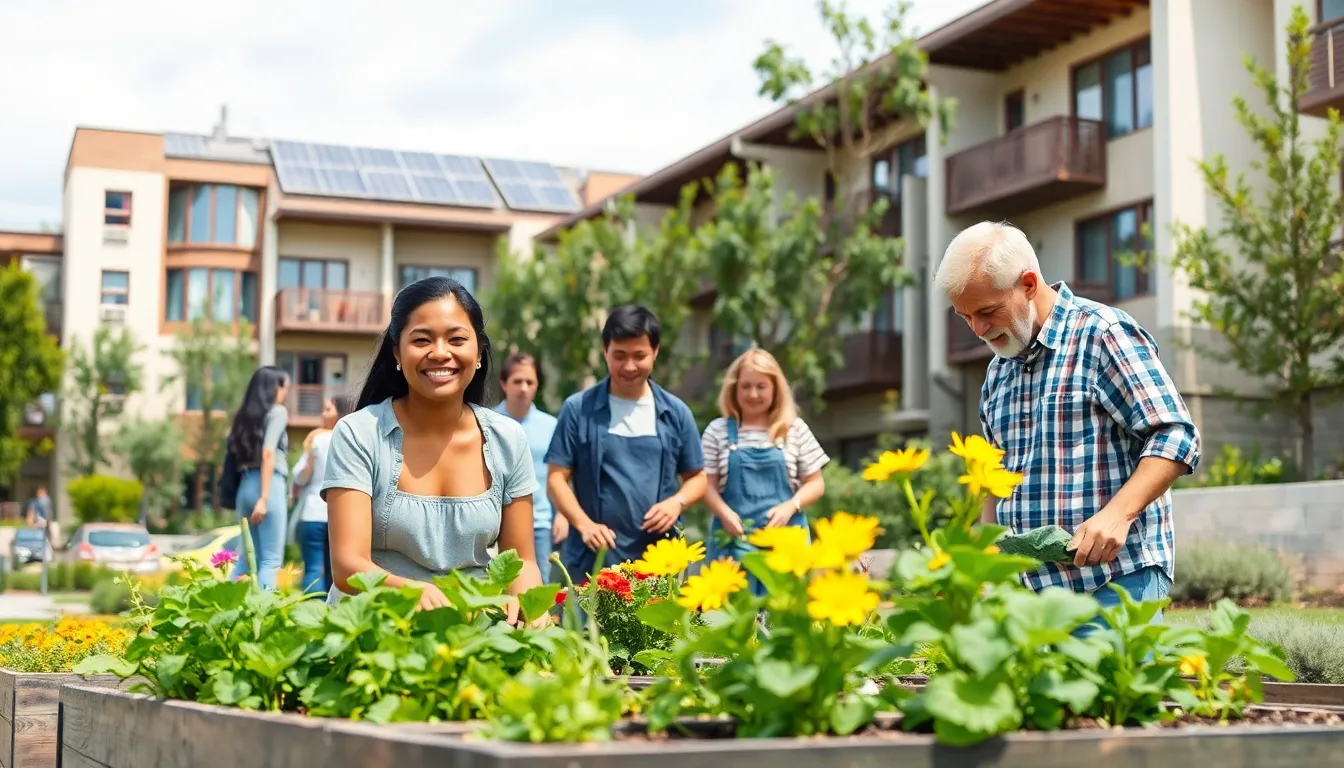In a world where the planet seems to be giving us the side-eye, sustainable apartment living is the superhero we didn’t know we needed. Imagine a lifestyle that not only saves the Earth but also saves you some serious cash. Who wouldn’t want to live in a cozy space that’s eco-friendly and wallet-friendly? It’s like having your cake and eating it too—while using a biodegradable fork, of course.
Sustainable living in apartments isn’t just for tree-huggers and eco-warriors; it’s for anyone who wants to make a difference without sacrificing comfort. From energy-efficient appliances to composting bins that even your cat won’t judge you for, the options are endless. Dive into the delightful world of sustainable apartment living and discover how easy it is to become a green champion in your own home.
Table of Contents
ToggleUnderstanding Sustainable Apartment Living
Sustainable apartment living integrates eco-friendly practices into daily life. This lifestyle enhances environmental responsibility and reduces living expenses.
Definition of Sustainable Living
Sustainable living involves making choices that minimize environmental impact. It focuses on using resources efficiently, reducing waste, and choosing renewable alternatives. Residents adopt practices like energy conservation, waste reduction, and sustainable sourcing. For example, using energy-efficient appliances directly reduces electricity consumption. Implementing water-saving fixtures can cut water use significantly. Emphasizing a balanced approach ensures that individuals meet their needs without compromising future generations.
Importance of Sustainability in Urban Areas
Sustainability plays a critical role in urban areas due to their dense populations. High concentrations of people increase resource demand, leading to waste and pollution. Focused efforts in sustainability help alleviate these issues by lowering carbon footprints. Green spaces, such as community gardens, improve air quality while promoting biodiversity. Additionally, energy-efficient buildings can significantly reduce energy consumption. Urban sustainability efforts enhance quality of life, decrease environmental degradation, and promote healthier communities.
Key Features of Sustainable Apartments

Sustainable apartments often incorporate various features that enhance environmental responsibility. These characteristics contribute not only to lower utility costs but also to an overall healthier living experience.
Energy Efficiency
Energy efficiency stands as a cornerstone of sustainable apartments. High-efficiency appliances significantly reduce energy consumption. Residents frequently benefit from features like LED lighting, smart thermostats, and superior insulation. These elements enhance comfort while lowering both electricity bills and carbon footprints. Advanced energy management systems monitor usage, ensuring optimal efficiency. Green certifications, such as ENERGY STAR, validate these efforts, confirming that apartments meet rigorous energy standards.
Water Conservation
Water conservation plays a crucial role in sustainable living. Low-flow fixtures, such as faucets and showerheads, drastically minimize water usage without sacrificing comfort. Rainwater harvesting systems capture and store rainwater, providing an alternative source for irrigation and non-potable uses. Moreover, drought-resistant landscaping requires minimal water maintenance. Residents enjoy beautiful outdoor spaces while substantially cutting water costs. Implementing these strategies promotes a sustainable lifestyle that benefits both the community and the environment.
Sustainable Materials and Design
Sustainable materials and design shape the aesthetic and functional aspects of sustainable apartments. Environmentally friendly building materials, like reclaimed wood and bamboo, reduce environmental impact while promoting durability. Designs that maximize natural light reduce reliance on artificial lighting, enhancing energy savings. Furthermore, incorporating local materials supports regional economies and decreases transportation emissions. Sustainable apartments often feature green roofs and living walls, enhancing air quality and promoting biodiversity. These design choices work together to create attractive, functional spaces that embody sustainability.
Benefits of Sustainable Apartment Living
Sustainable apartment living offers numerous advantages that benefit individuals and the community.
Environmental Impact
Reduction of carbon footprints marks a significant benefit of sustainable living. Utilizing energy-efficient appliances lowers energy consumption drastically. Composting organic waste diverts it from landfills, which helps decrease methane emissions. Moreover, water-efficient fixtures significantly conserve water resources, helping to combat water scarcity. Enhancing biodiversity through the incorporation of green spaces promotes a healthier ecosystem. These practices collectively contribute to a more sustainable environment that supports urban wildlife.
Economic Savings
Cost savings manifest as a direct benefit of sustainable apartment living. Lower energy bills result from using high-efficiency appliances and LED lighting. Owners enjoy reduced maintenance costs due to the durability of sustainable materials. Additionally, rebates and incentives from local governments often reward green initiatives, providing further financial relief. Over time, these savings accumulate, making sustainable options economically advantageous for residents. Investing in sustainability ultimately pays off, creating a win-win scenario for both individuals and communities.
Health and Well-being
Health benefits arise from embracing sustainable living practices. Improved indoor air quality results from using non-toxic materials and natural ventilation strategies. Access to green spaces encourages physical activity and enhances mental well-being. Sustainable design also maximizes natural light, benefiting mood and productivity. Incorporating these elements fosters a living space that nurtures both health and comfort. Prioritizing wellness through sustainable practices creates a happier, more vibrant community for everyone involved.
Tips for Adopting Sustainable Practices at Home
Sustainable living at home can incorporate various straightforward practices. Readers can start by reducing waste, implementing energy-saving measures, and supporting local brands that prioritize sustainability.
Reducing Waste
Reducing waste forms a critical part of sustainable living. Utilize reusable items like bags, bottles, and containers. Composting food scraps not only decreases landfill waste but enriches the soil for gardening. Many residents overlook the significance of recycling electronics and hazardous materials, which often require special disposal methods. Buying in bulk helps minimize packaging waste, while requesting minimal packaging from local retailers fosters responsible practices. Everyone can contribute to waste reduction by being conscious consumers.
Implementing Energy-Saving Measures
Implementing energy-saving measures significantly lowers both energy consumption and costs. Start with switching to LED bulbs, as they consume up to 75% less energy than traditional incandescent bulbs. Using smart thermostats allows individuals to regulate heating and cooling efficiently. Unplugging devices when not in use also prevents energy waste. Residents can further enhance energy efficiency by sealing windows and doors to avoid drafts. Maintaining appliances regularly, like cleaning filters and checking seals, leads to optimal functioning and energy conservation.
Supporting Local and Sustainable Brands
Supporting local and sustainable brands fosters community development and reduces carbon footprints. Choosing locally sourced food limits transportation emissions while bolstering local economies. Shoppers often find that local businesses prioritize ethical practices and sustainable materials in their products. When selecting household items, opting for certifications indicating environmental responsibility ensures better choices. Exploring farmers’ markets or community-supported agriculture programs introduces residents to seasonal produce while connecting with local farmers. Embracing these practices not only promotes sustainability but enriches community ties.
Sustainable apartment living offers a pathway to a healthier and more responsible lifestyle. By adopting eco-friendly practices residents can significantly reduce their environmental impact while enjoying economic benefits. Embracing energy-efficient appliances and water conservation methods not only enhances comfort but also fosters a sense of community responsibility.
As urban areas continue to grow the importance of sustainability becomes even more pronounced. Every small action contributes to a larger movement towards greener living spaces. By prioritizing sustainability individuals can create vibrant homes that reflect their commitment to the planet and future generations.






